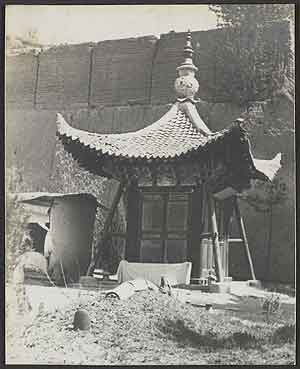|
|||||||||
|
NEW SCHOLARSHIPThe Photographs of Claude L. Pickens Title: Hsuan Hua Kang, Kansu. Ma Yuan-chang's grave. Work Type: photographs Creator: Pickens Jr., Rev. Claude L. (1900-1985), United States, photographer Date: 1936 Dimensions: 8 x 6.5 cm. Associated Name: Ma Yuanchang (d. 1920), China, associated name Topics: graves; shrines Materials/Techniques: gelatin silver process on paper Location: Grave of Ma Yuanzhang, Hsüan-hua-kang, Zhangjiachuan (near), Gansu Sheng, China Related Work: Part of Rev. Claude L. Pickens, Jr. collection on Muslims in China Repository: Harvard-Yenching Library CP02.22.01 [Reproduced with permission.] Harvard University has a major collection of photographic material related to Chinese Muslims during the Republican period. The material includes a valuable collection of photographs made by the Rev. Claude L. Pickens, Jr., who was active in the Society of Friends of the Moslems in China as a missionary with the Foreign and Domestic Missionary Society. Over 1000 photos of Muslims and Christian missionaries working among them in Western China in the 1920s and 1930s form the core of this collection, which is supplemented by several hundred books, pamphlets, etc., and so on, in several languages. The material is a gift of Rev. Claude L. Pickens, Jr., a bequest made in memory of Joseph Fletcher, Professor of Chinese and Inner Asian History at Harvard University. The collection consists of three parts:
The Pickens website will provide some context to these materials, and for each digitized image there will be a full record of provenance, date, place, etc. The images are scanned at two resolutions and the best is stored in the collection's digital repository; the lower resolution image in the online catalog is sufficient for viewing. To obtain higher resolution images for publication, and so on, it is necessary to request permission and pay a fee. The albums and photographs can be viewed in the VIA (Visual Access Catalog) http://via.harvard.edu/. A finding aid to the printed materials can be viewed in the OASIS http://oasis.harvard.edu/ online catalogue. In both catalogues, use "Pickens" and "Muslims" as search terms. A Biographical Note on Claude L. PickensClaude Leon Pickens, Jr., was born in Alexandria, Virginia, in 1900. He received an A.B. from the University of Michigan in 1923 and two years later married Nellie Elizabeth Pickens, daughter of Amy and Samuel M. Zwemer. Born in Bahrain in 1899, Elizabeth was educated in Arabia, Egypt, and Michigan. She graduated from Hope College and, after a year at the University of Michigan Medical School, left to become a nurse in the U.S. Army. In 1926, Claude Pickens earned a B.D. from the Theological Seminary in Virginia, and was ordained as Episcopal priest at Rock Creek Church in Washington, DC. That year the couple left for China under the auspices of the Foreign and Domestic Missionary Society (FDMS) of the Protestant Episcopal Church. After attending language school in Nanjing, they fled Chiang Kai-shek's advancing army and relocated in Shanghai. There Pickens met Isaac Mason and joined the Society of Friends of the Moslems in China (FOM), serving as its Secretary. Elizabeth Pickens edited the Society's newsletter. From 1927 to 1937, Pickens worked in river ports along the Yangzi and for the Episcopal Diocese in Hankou, where he was assistant pastor to the Chinese pastor at St. Peter's Church. Elizabeth Pickens conducted a well baby clinic. In 1933, accompanied by Samuel M. Zwemer, and again in 1936, Claude Pickens and other China missionaries made surveys of Muslims in northwest China, northeast Tibet, and Inner Mongolia. From 1937-1938, during the Sino-Japanese war, Pickens was on leave in the U.S. and in Zamboanga, Philippine Islands, where he worked with Muslims. In 1939, the family returned to central China. During WWII , they were held from 1941-1942 by the Japanese as prisoners of war; then from 1942-1945 Pickens worked for the FDMS in New York City and attended Columbia University. In 1945, he received an M.A. from the Department of Chinese and Japanese; his thesis was titled "Annotated bibliography of literature on Islam in China." After WWII the Pickens family returned to central China where Claude Pickens was Canon of St. Paul's Cathedral, Hankou, until 1950 when the family returned to New York. From 1953 to 1965, Claude Pickens worked with the National Council of Churches' Student Volunteer Movement and then with foreign students in New York City for the FDMS-Episcopal Church Center. In 1962, he took a leave to minister to Aramco employees in Arabia. Claude Pickens retired to Annisquam, MA, in 1969 to study and write. He died there in 1985 and his wife Elizabeth died the following year. [We are grateful to Raymond Lum of Harvard-Yenching Library (rlum@fas.harvard.edu), Harvard University, for providing this material. We would also like to thank Claire Roberts of the Powerhouse Museum, Sydney, for alerting us to this material in the Harvard-Yenching collection.] |